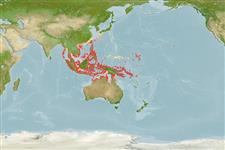>
Eupercaria/misc (Various families in series Eupercaria) >
Nemipteridae (Threadfin breams, Whiptail breams)
Etymology: Scolopsis: Name from the Greek masculine noun 'skolos' meaning 'thorn' and suffix '-opsis' (from Greek feminine n. 'opsis' meaning 'aspect', 'appearance') meaning ‘thorny appearance’ presumably referring to 'les dentelures de la préopercule, en ont aussi, et même d'épineuses, aux sous-orbitaires' mentioned by Cuvier (1814) in his designation of the genus. Name ending in -'opsis' are treated as feminine according to ICZN 1999: Article 30.1.2 (Ref. 130620).
More on author: Lacepède.
Environment: milieu / climate zone / profondeur / distribution range
Écologie
marin; saumâtre récifal; profondeur 2 - 25 m (Ref. 90102). Tropical; 33°N - 16°S, 90°E - 170°E (Ref. 3810)
Indo-West Pacific: Andaman Sea, Ryukyu Islands, Philippines, Indonesia, Solomon Islands and Vanuatu.
Taille / Poids / Âge
Maturité: Lm ? range ? - ? cm
Max length : 25.0 cm TL mâle / non sexé; (Ref. 90102); common length : 10.0 cm SL mâle / non sexé; (Ref. 3810)
Épines dorsales (Total) : 10; Rayons mous dorsaux (Total) : 8 - 9; Épines anales: 3; Rayons mous anaux: 7 - 8; Vertèbres: 24. Body is olive above and white below, with a silvery-white stripe on the back beneath the dorsal fin. A row of golden yellow spots are on the sides, mid laterally from behind the tip of the pectoral fin to the caudal peduncle. The upper and lower edges of the caudal fins are reddish (Ref. 3810).
Body shape (shape guide): fusiform / normal; Cross section: oval.
Inhabits sandy bottoms close to coral reefs. Also near mangroves (Ref. 48635). Frequently in silty areas with low visibility (Ref. 90102). Occurs often in small groups. Feeds on benthic invertebrates and small fishes.
Life cycle and mating behavior
Maturité | Reproduction | Frai | Œufs | Fécondité | Larves
Russell, B.C., 1990. FAO Species Catalogue. Vol. 12. Nemipterid fishes of the world. (Threadfin breams, whiptail breams, monocle breams, dwarf monocle breams, and coral breams). Family Nemipteridae. An annotated and illustrated catalogue of nemipterid species known to date. FAO Fish. Synop. 125(12):149p. Rome: FAO. (Ref. 3810)
Statut dans la liste rouge de l'IUCN (Ref. 130435: Version 2025-1)
Menace pour l'homme
Harmless
Utilisations par l'homme
Pêcheries: pêcheries vivrières
Outils
Articles particuliers
Télécharger en XML
Sources Internet
Estimates based on models
Preferred temperature (Réf.
123201): 26.3 - 29.3, mean 28.8 °C (based on 1970 cells).
Phylogenetic diversity index (Réf.
82804): PD
50 = 0.5000 [Uniqueness, from 0.5 = low to 2.0 = high].
Bayesian length-weight: a=0.01820 (0.01054 - 0.03142), b=3.06 (2.92 - 3.20), in cm total length, based on LWR estimates for this species & Genus-body shape (Ref.
93245).
Niveau trophique (Réf.
69278): 3.7 ±0.52 se; based on food items.
Résilience (Réf.
120179): Haut, temps minimum de doublement de population inférieur à 15 mois (Preliminary K or Fecundity.).
Fishing Vulnerability (Ref.
59153): Low vulnerability (15 of 100).
🛈
Nutrients (Ref.
124155): Calcium = 62 [38, 132] mg/100g; Iron = 0.658 [0.316, 1.447] mg/100g; Protein = 19.4 [17.4, 21.1] %; Omega3 = 0.16 [0.09, 0.28] g/100g; Selenium = 23.7 [13.2, 46.5] μg/100g; VitaminA = 77.5 [20.1, 251.5] μg/100g; Zinc = 1.5 [1.0, 2.2] mg/100g (wet weight);
